
The 99 different species of trees documented in Ohio provide a wide range of benefits to the local environment. Not only do they provide shade and make the area beautiful, but they also help improve air quality. Trees absorb carbon dioxide from the atmosphere and release oxygen back into it, helping to reduce greenhouse gas emissions.
Additionally, these living resources offer shelter for wildlife such as birds, squirrels, and chipmunks, providing them with much-needed protection from predators. The trees also serve as a food source for deer, who feed on their leaves or nuts that may grow on them. Humans benefit from eating nuts and syrups too!
Furthermore, when certain tree types are planted in urban areas, they can act as noise barriers by absorbing sound waves and decreasing sound levels by up to 50%. And, of course, there is the beneficial wood that we use to heat our homes, make lumber and paper, and generate income.
Finally, many insects rely on trees during their lifecycle stages; butterflies depend on particular types of flowers that grow exclusively on certain species of trees. Other insects benefit from dead wood habitats offered by mature trees, which are essential for their development. All these factors make Ohio’s forests a haven for native wildlife!
1. American Beech
The American Beech (Fagus grandifolia) is a tree native to Ohio. It is found in moist, rich forests throughout the region. This species often grows tall and exhibits a dense canopy of leaves that provide shade for local wildlife. The nuts produced by this tree are an important food source for various wildlife, including birds, squirrels, chipmunks, deer, and foxes.
Additionally, its bark provides shelter and nesting sites for insects like bees and butterflies. Furthermore, its roots help stabilize the soil in forests, providing stability to plant communities and helping prevent erosion caused by water runoff or windstorms. The American Beech offers numerous environmental benefits to Ohio’s local wildlife through its shade-producing canopy, nutritious nuts, protective bark, and partially hollow trunk to make a cozy den.
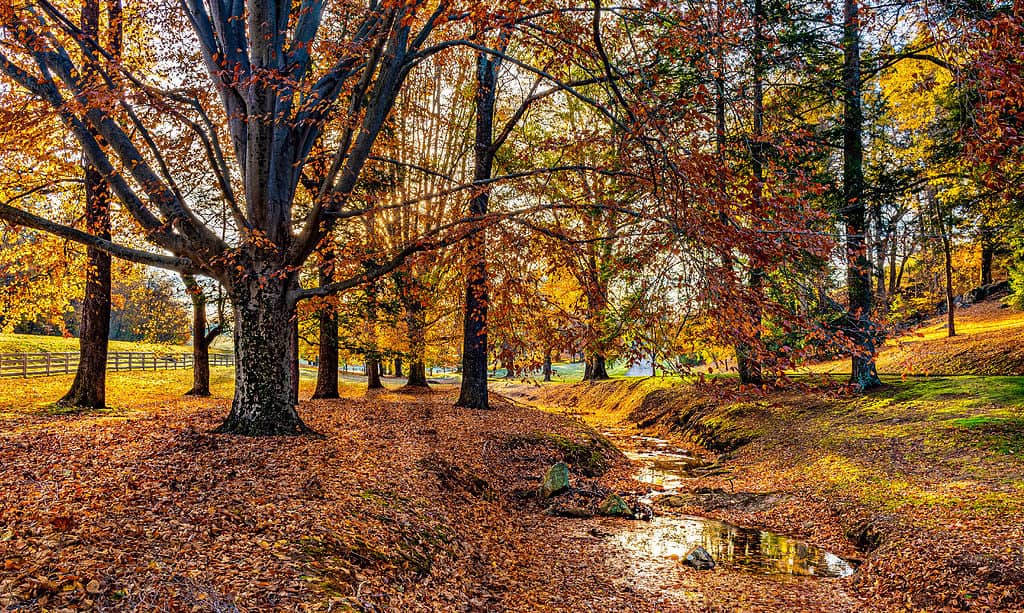
American Beech (
Fagus grandifolia) offers numerous environmental benefits to Ohio’s local wildlife.
©Gerry Bishop/Shutterstock.com
2. Black Locust
The black Locust (Robinia pseudoacacia) is a deciduous tree native to the state of Ohio. It can grow up to 70 feet tall and has an open, spreading crown with numerous branches. The bark is smooth in young trees but becomes rough and deeply furrowed as it matures. Its foliage consists of leaves that are green during the summer and yellow during the fall.
Black locust produces clusters of fragrant white flowers in spring, followed by long seedpods filled with small black seeds, making it an excellent pollinator tree. This species also provides shelter from harsh weather conditions and offers excellent bird nesting sites due to its dense canopy of foliage.
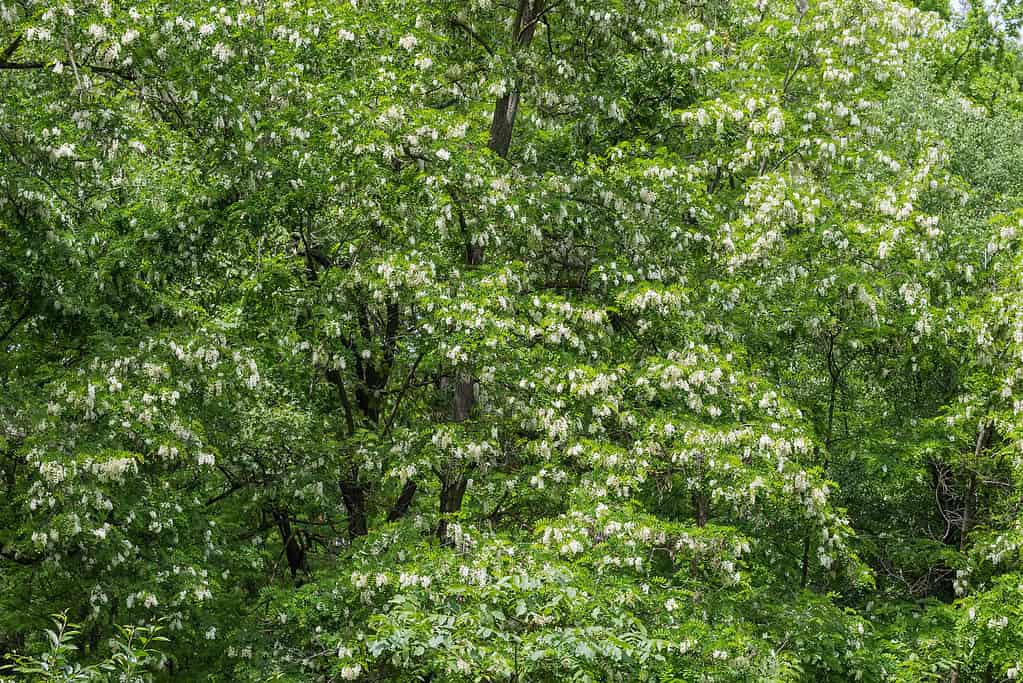
Black locust (
Robinia pseudoacacia) produces clusters of fragrant white flowers in spring.
©iStock.com/anmbph
3. Northern Catalpa
Northern catalpa (Catalpa speciosa) is a large deciduous tree introduced to Ohio over 200 years ago. It can grow up to 70 feet tall and has a spreading, irregular crown. Its bark is gray-brown in color, with shallow ridges and furrows running along its length. The leaves are heart-shaped, pointed at the tip, light green in color, and have smooth edges.
In the summertime, northern catalpa produces clusters of white flowers that give off an unforgettable fragrance, as well as long seed pods which contain numerous seeds for wildlife consumption. Northern catalpas provide invaluable food sources for birds such as robins, cuckoos, and cardinals during winter months when other food sources may be scarce or unavailable. These trees also attract bees who harvest their nectar for honey production, providing yet another benefit to the local wildlife!
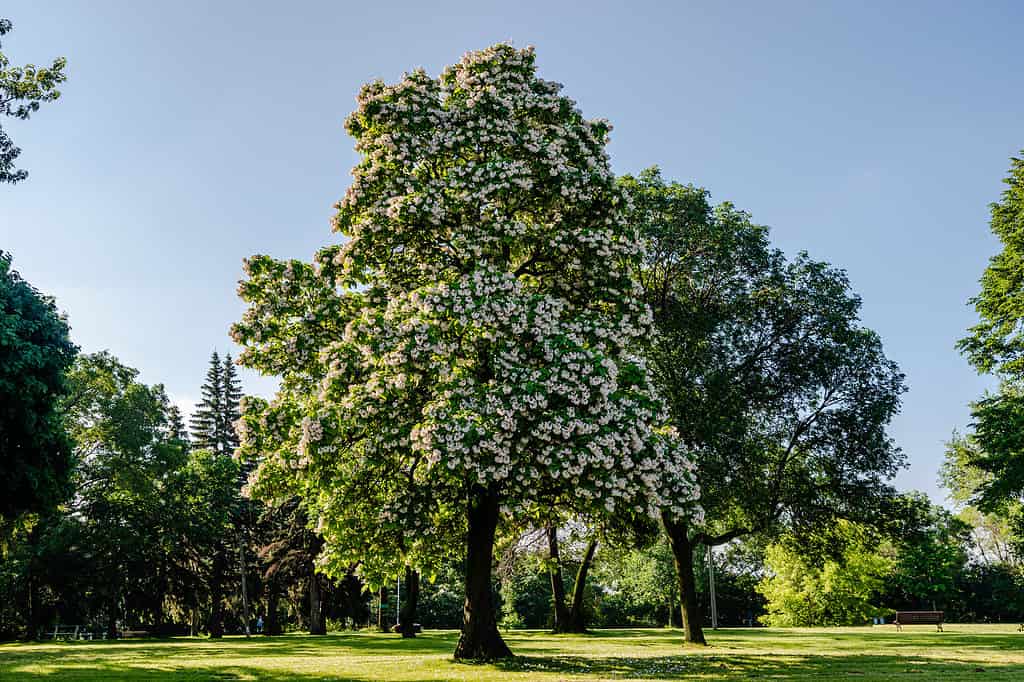
Northern catalpa (
Catalpa speciosa) is a beautiful deciduous tree native to Ohio with a spreading, irregular crown.
©iStock.com/Pito Fotos
4. Black Birch
Black birch (Betula lenta) is a deciduous tree native to a few counties in Ohio. It is also called sweet birch and cherry birch. This tree provides excellent nesting and foraging habitats for local wildlife, as well as an important source of food during winter. Its leaves are dark, shiny green, turning yellow and gold in the fall before being shed. The bark has deep furrows that can easily be seen from afar.
Black birch also produces edible nuts, which provide essential nutrients to small animals such as squirrels and chipmunks. Additionally, its sap can be used to make birch beer or birch sugar – making it a valuable resource for both humans and animals alike!

Black birch (also known as sweet cherry) sap can be used to make birch beer or birch sugar.
Image: lis_wilks, Shutterstock
©lis_wilks/Shutterstock.com
5. American Elm
American elm (Ulmus americana) is a deciduous tree native to the state of Ohio. It has been hit hard by Dutch elm disease recently, and few mature specimens can be found in the state. It typically grows up to 80-120 feet tall and spreads between 50-70 feet wide, with gray bark and a vase-shaped crown. The American elm produces seeds in a thin papery wing about half an inch long.
American elms provide a habitat for birds and other local wildlife due to their large size while also offering shade from harsh sunlight during hot summer days. This species is known for its tolerance of urban conditions like air pollution, making it an ideal choice for planting along city streets or parks.

American elm (
Ulmus americana) typically grows up to 80-120 feet tall and spreads between 50-70 feet wide.
©iStock.com/marekuliasz
6. Persimmon
The persimmon (Diospyros virginiana) is native to the state of Ohio. You can find it in many places throughout the southern and eastern regions. It is a deciduous tree, reaching up to 60 feet when mature, with dark gray bark that has a blocky texture.
This species is prized for its edible plum-like fruit that changes from green to pinkish orange when ripe. Humans and many birds and animals, including squirrels, deer, skunks, and raccoons, enjoy these fruits. In addition to providing food for these animals, the persimmon also provides hardwood traditionally used to make wooden golf clubs and billiard balls.

Persimmon trees (
Diospyros virginiana) can be found in southern and eastern Ohio, with a fruit that’s popular with humans, birds, and animals.
©iStock.com/cbglp2
7. Ohio Buckeye
The Ohio buckeye tree (Aesculus glabra) is a beautiful and iconic species of hardwood tree native to the state of Ohio. It is so important that it is the official state tree! It’s easily recognizable by its six-inch leaves with five long narrow leaflets. The tree has a lovely rounded crown, and its ridged and fissured bark is light gray or brown.
The Ohio buckeye produces clusters of yellow-green flowers in springtime that are attractive to pollinators like bees, butterflies, and hummingbirds. In autumn, the buckeye produces husks filled with brown nuts. The nut-like seeds feature a pale scar or ‘eye.’ These nuts are poisonous to humans but are a beloved food of squirrels, deer, and other small mammals for sustenance during cold winters.
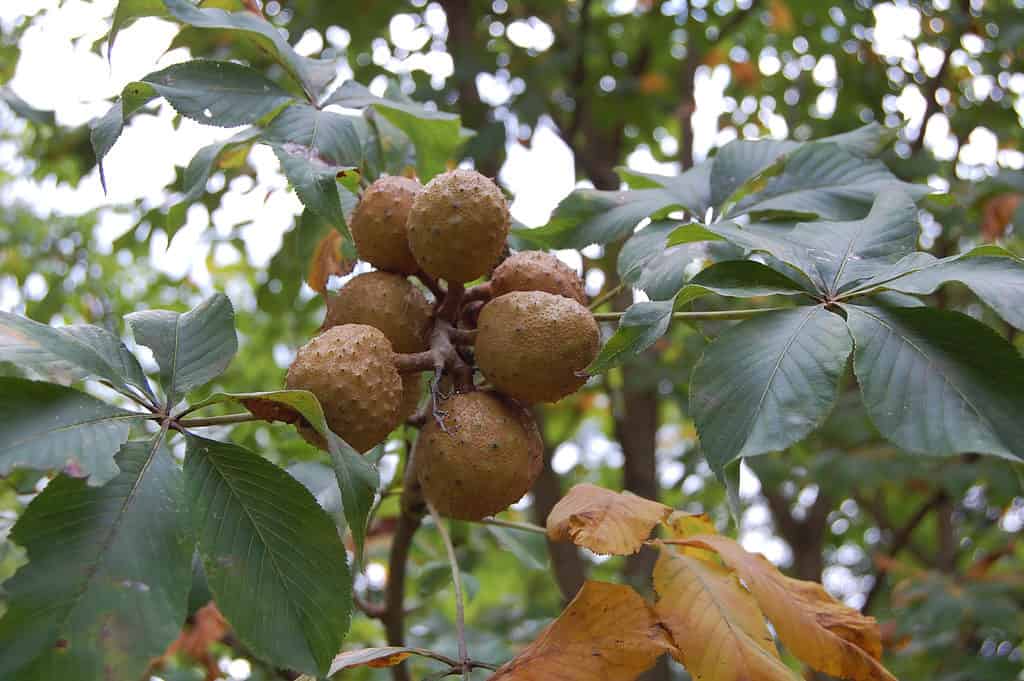
The Ohio buckeye (
Aesculus glabra) is the official state tree.
©CountryGirl624/Shutterstock.com
8. Sassafras
Sassafras (Sassafras albidum) is a deciduous tree native to the state of Ohio and can be found throughout eastern North America. It is a common fence row tree because it colonizes rapidly to form a thicket. It usually grows to a height of 30-60 feet and has three different shaped leaves: oval, mitten, or three-lobed. The tree has many uses, including soap, perfume, tea, and root beer.
In addition, the sweetly scented flowers attract an array of pollinators like butterflies and bees, which help support local wildlife in Ohio. Furthermore, Sassafras fruits nourish many species, including birds, deer, squirrels, and raccoons, who feed on its fruit during fall months when food supplies are scarce.
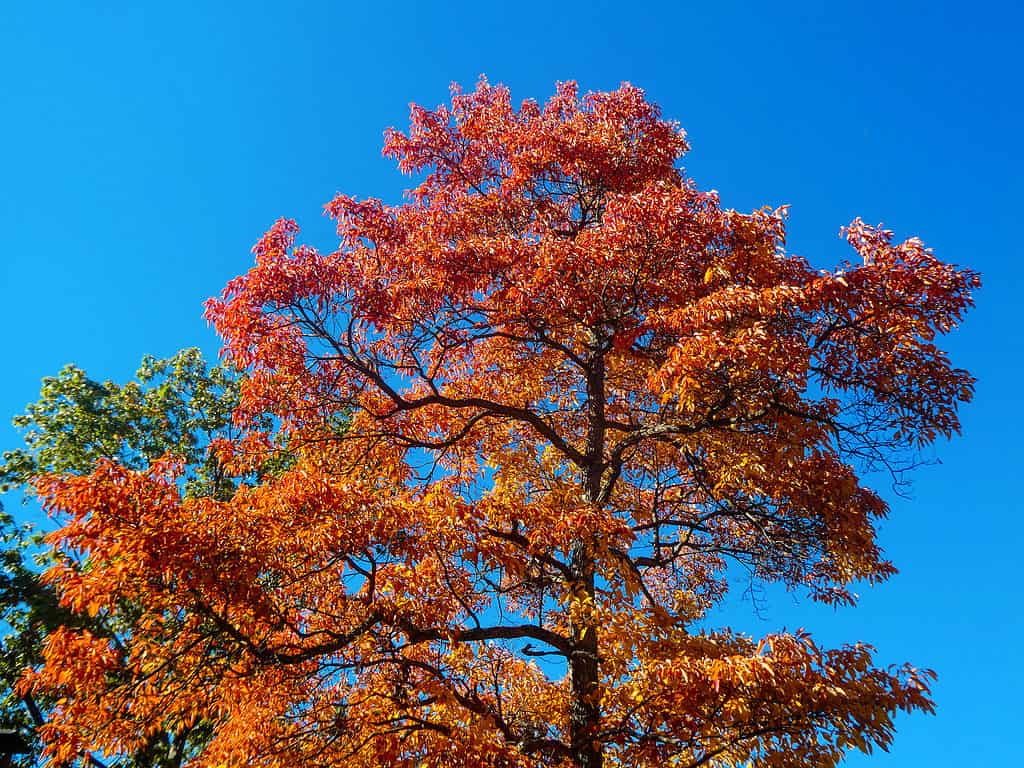
Humans have found a use for all parts of the Sassafras albidum plants, including its leaves, stems, bark, roots, wood, flowers, and fruit.
©ForestSeasons/Shutterstock.com
9. American Basswood
American basswood (Tilia americana) is a tree that is native to the state of Ohio and can be found in woodlands, riverbanks, and old fields. It grows up to 90 feet tall with a straight trunk and oval-shaped crown. Its bark is scaly, and its dark green leaves are heart-shaped with serrated edges.
The fragrant flowers are small but abundant, and bees use their nectar to make delicious honey. American basswood produces a fruit that is food for wildlife, such as birds, squirrels, deer, raccoons, rabbits, foxes, and bears. This tree also serves as a habitat for many species of animals due to its large canopy providing shelter from predators or extreme weather conditions. In addition, it helps improve air quality by absorbing pollutants from the atmosphere helping create healthier environments for us all!

American basswood (
Tilia americana) has heart-shaped leaves with serrated edges and .produces small, fragrant flowers.
©Alina Vaska/Shutterstock.com
10. Cucumbertree
The cucumbertree (Magnolia acuminata) is a species of tree native to the state of Ohio. It is known for its large, light green leaves and yellow-green flowers that bloom in a unique upward-facing fashion. The fruit of the cucumbertree resembles a small green cucumber, hence its name.
This species provides food and shelter for many local animals, including birds, squirrels, and deer. Additionally, it is an important source of nectar for pollinators such as bees and butterflies, which helps support healthy ecosystems in Ohio’s forests and beyond!

Cucumbertree (
Magnolia acuminata) has large, light green leaves and fruit that resembles a small green cucumber.
©Baummapper, CC BY-SA 3.0 DE <https://creativecommons.org/licenses/by-sa/3.0/de/deed.en>, via Wikimedia Commons – License
11. Sugar Maple
The sugar maple (Acer saccharum) is a large deciduous tree native to Ohio. It grows best in deep, moist soils. It can reach heights of 70-100 feet, making it one of the tallest trees in Ohio. Its five-lobed leaves are green in the summer and turn stunning shades of red, yellow, and orange in the fall. In spring, it produces small yellow flowers, which give way to clusters of winged seeds called samaras by summer’s end.
Sugar maples serve an important role for local wildlife, providing food and shelter to many species of birds, mammals, amphibians, reptiles, and insects. Raccoons, squirrels, chipmunks, and deer eat its fruit. At the same time, its foliage provides nesting material for birds like robins and warblers, who also feed on its buds and sap during winter. Some butterfly species use this tree’s nectar for sustenance, while others lay eggs on or near it so their larvae can feed upon its leaves once hatched.

Sugar maple (
Acer saccharum) is native to Ohio with five-lobed leaves that turn stunning shades of red, yellow, and orange in the fall.
©Mircea Costina/Shutterstock.com
12. Red Mulberry
Red mulberry (Morus rubra) is a deciduous tree native to the state of Ohio. It is adaptable to many types of soil and can reach heights up to 60 feet tall. The bark of this species is golden-brown and fissures with age. Its leaves are dull green and four to six inches long with a serrated or toothed edge. Its flowers bloom white in April or May before producing sweet fruits that ripen into a dark red or purple and resemble blackberries.
Red mulberry provides habitat for many local birds, such as robins, cedar waxwings, mockingbirds, cardinals, catbirds, and blue jays, who rely on its fruit for nutrition during migration periods or while nesting nearby. As you can imagine, sweet, ripe fruits are a favorite food of squirrels, raccoons, deer, and many other mammals.
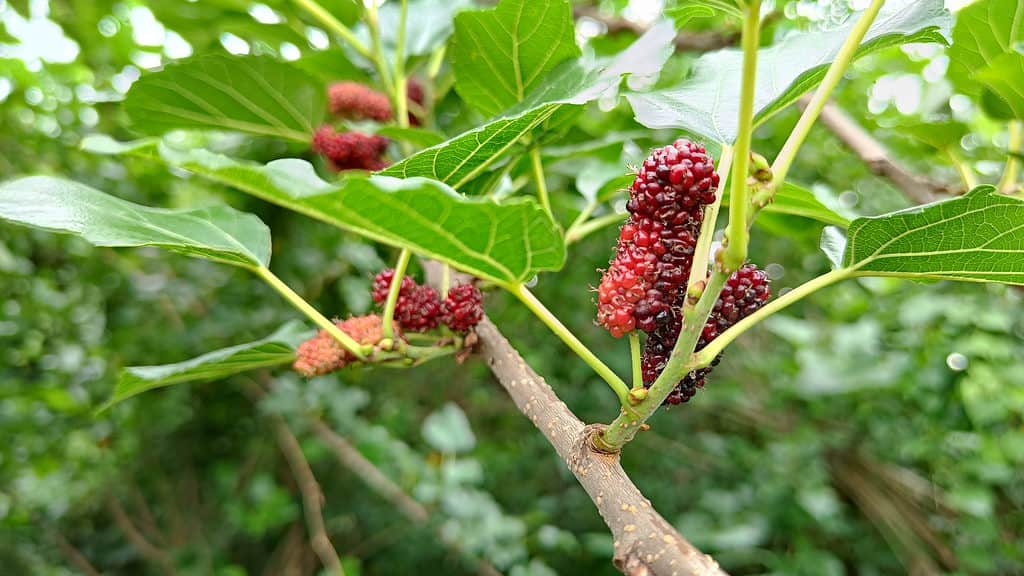
Red mulberry (
Morus rubra) produces sweet dark red or purple fruit that birds and animals in Ohio rely on.
©iStock.com/Witsanu Patipatamak
A Summary of 12 Beautiful Trees Native to Ohio
| # | Tree | Appearance |
|---|---|---|
| 1 | American Beech | Grows tall with a dense canopy of leaves |
| 2 | Black Locust | Tall with an open, spreading crown with numerous branches |
| 3 | Northern Catalpa | Tall with has a spreading, irregular crown and heart-shaped leaves |
| 4 | Black Birch | Dark, shiny green leaves that turn gold in the fall |
| 5 | American Elm | Tall with gray bark and a vase-shaped crown |
| 6 | Persimmon | Tall with dark gray bark and delicious orange-colored fruit |
| 7 | Ohio Buckeye | Six-inch leaves with five long narrow leaflets, a lovely rounded crown, and ridged bark in brown or gray, flowers and produces nuts |
| 8 | Sassafras | Tall with leaves of three different shapes |
| 9 | American Basswood | Tall with a straight trunk and oval-shaped crown, scaly bark, and its dark green leaves are heart-shaped with serrated edges – fragrant flowers |
| 10 | Cucumbertree | Large, light green leaves, and yellow-green flowers that bloom in a unique upward-facing fashion |
| 11 | Sugar Maple | Tall with stunning fall foliage |
| 12 | Red Mulberry | Leaves are dull green and four to six inches long with a serrated or toothed edge – flowers bloom white before yielding fruit |
The photo featured at the top of this post is © Dan Keck / Flickr – License / Original
Sources
- Ohio Department of Natural Resources, Available here: https://ohiodnr.gov/static/documents/wildlife/backyard-wildlife/Pub%205509%20Trees%20of%20Ohio%20Field%20Guide.pdf
- Ohio Native Plant Month, Available here: https://www.ohionativeplantmonth.org/ohio-native-plants-of-distinction
- Athens Soil and Water Conservation District, Available here: https://www.athensswcd.org/uploads/3/0/1/0/30105193/ohiotreesbooklet.pdf
- Ohio Magazine, Available here: https://www.ohiomagazine.com/home-garden/article/10-native-plants-that-thrive-in-ohio
Thank you for reading! Have some feedback for us? Contact the AZ Animals editorial team.






